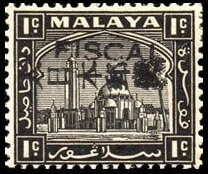Stamp: Mosque and Palace in Klang (Kelantan, Japanese Occupation 1943)
Mosque and Palace in Klang (Kelantan, Japanese Occupation 1943)
01 August (Kelantan, Japanese Occupation ) within release Fiscal goes into circulation Stamp Mosque and Palace in Klang face value 1 Malayan cent
Stamp is horizontal format.
Selangor Postage & Revenue stamp with a Kanji overprint, further overprinted "FISCAL" in black Revenue Reverend cat. no: L61Also in the issue Fiscal:
- Stamp - Coat of arms of Negri Sembilan face value 2;
- Stamp - Coat of arms of Negri Sembilan face value 2;
- Stamp - Coat of arms of Negri Sembilan face value 3;
- Stamp - Coat of arms of Negri Sembilan face value 25;
- Stamp - Fruit face value 2;
- Stamp - King George VI (1895-1952) face value 2;
- Stamp - Mosque and Palace in Klang face value 1;
- Stamp - Sultan Abu Bakar (1904-1974) face value 10;
- Stamp - Sultan Abu Bakar (1904-1974) face value 25;
- Stamp - Sultan Abu Bakar (1904-1974) face value 25;
- Stamp - Sultan Iskandar (1881-1938) face value 2;
- Stamp - Sultan Iskandar (1881-1938) face value 2;
- Stamp - Sultan Iskandar (1881-1938) face value 2;
- Stamp - Sultan Iskandar (1881-1938) face value 10;
- Stamp - Sultan Iskandar (1881-1938) face value 50;
- Stamp - Hydroelectric Power Station face value 3;
Stamp Mosque and Palace in Klang it reflects the thematic directions:
Mosquitoes, the Culicidae, are a family of small flies consisting of 3,600 species. The word mosquito (formed by mosca and diminutive -ito) is Spanish and Portuguese for little fly. Mosquitoes have a slender segmented body, one pair of wings, three pairs of long hair-like legs, and specialized, highly elongated, piercing-sucking mouthparts. All mosquitoes drink nectar from flowers; females of some species have in addition adapted to drink blood. The group diversified during the Cretaceous period. Evolutionary biologists view mosquitoes as micropredators, small animals that parasitise larger ones by drinking their blood without immediately killing them. Medical parasitologists view mosquitoes instead as vectors of disease, carrying protozoan parasites or bacterial or viral pathogens from one host to another.
A palace is a large residence, often serving as a royal residence or the home for a head of state or another high-ranking dignitary, such as a bishop or archbishop. The word is derived from the Latin name palātium, for Palatine Hill in Rome which housed the Imperial residences


